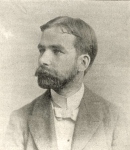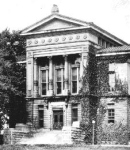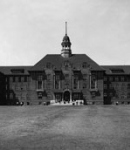-
1882: A history museum for the future
The Redpath Museum is the oldest building in Canada built as a museum, and today houses research labs, a Victorian auditorium, and extensive collections in the fields of paleontology, zoology, mineralogy, and world cultures (ethnology). The museum is open to the public.
Read more...
-
1884: McGill's women blazing trails
In 1884, women began attending classes at McGill—an advance made possible by benefactor Donald A. Smith (later Lord Strathcona). In Smith's honour, McGill’s female students were known for decades as "Donaldas." Female McGillians would go on to make landmark contributions in every field imaginable, and in 1912 McGill appointed Canada's first woman university professor: Carrie Derick, a pioneering geneticist who created the first ever course on genetics and evolution.
Read more...
In 1901, McGill physics professor Ernest Rutherford theorized that radioactivity was the product of fracturing atoms—and was duly heckled. Within months his biggest skeptic, Frederick Soddy, became Rutherford's chief collaborator in research that earned Nobel Prizes for both men. The duo showed that atoms can spontaneously decay, forming brand new kinds of matter, and today Rutherford is universally recognized as the father of nuclear physics.
Read more...
Since its founding more than a century ago, McGill's Macdonald Campus has turned agricultural studies on its head and sent thousands of grads out into the world armed with a world-beating know-how, a roll-up-your-sleeves attitude, and fond memories of an institution like no other.
Read more...
-
1908: Rising from the ashes: Macdonald Engineering
After the original Macdonald Engineering Building was gutted by fire in 1907, the current building was built with function and safety taking precedence over design. Yet one focal design feature was included: a phoenix rising from ashes, carved into the south wall as a reminder of building's rebirth.
 Robert Stanley Weir, BCL1880, DCL1897, was an accomplished teacher, lawyer and judge, and his poetry was good enough to earn him membership in the Royal Society of Canada. But we remember him for "O Canada." When the original French version of the song became hugely popular, scores of would-be songwriters took a stab at writing an English version. The one that won widespread public acceptance was penned by Weir in 1908. By the time the First World War erupted, his version of "O Canada" was the best-known patriotic song in the country—and it only took the federal government until 1980 to adopt it (with slight modification) as Canada's national anthem.
Robert Stanley Weir, BCL1880, DCL1897, was an accomplished teacher, lawyer and judge, and his poetry was good enough to earn him membership in the Royal Society of Canada. But we remember him for "O Canada." When the original French version of the song became hugely popular, scores of would-be songwriters took a stab at writing an English version. The one that won widespread public acceptance was penned by Weir in 1908. By the time the First World War erupted, his version of "O Canada" was the best-known patriotic song in the country—and it only took the federal government until 1980 to adopt it (with slight modification) as Canada's national anthem.

